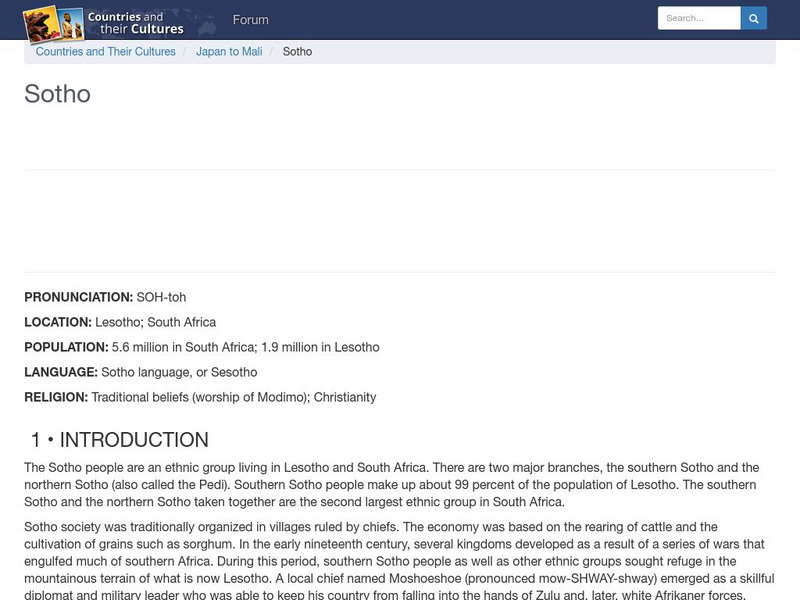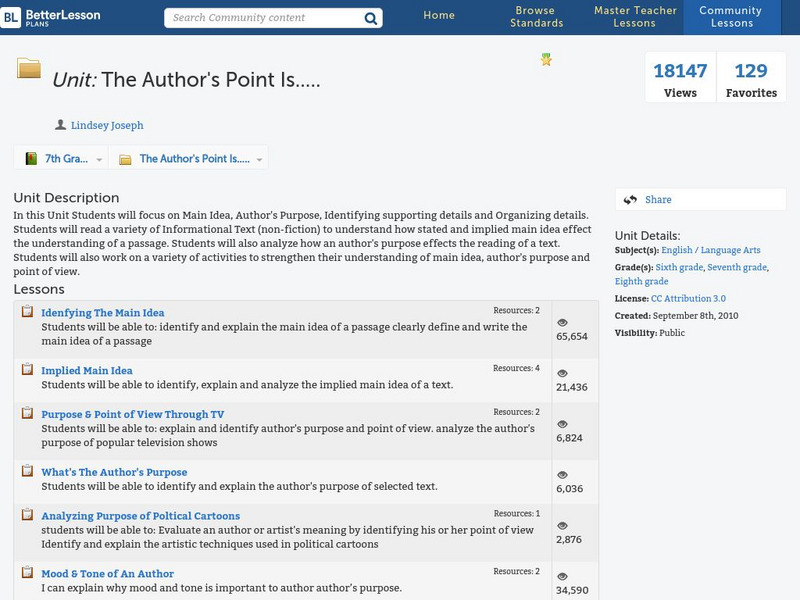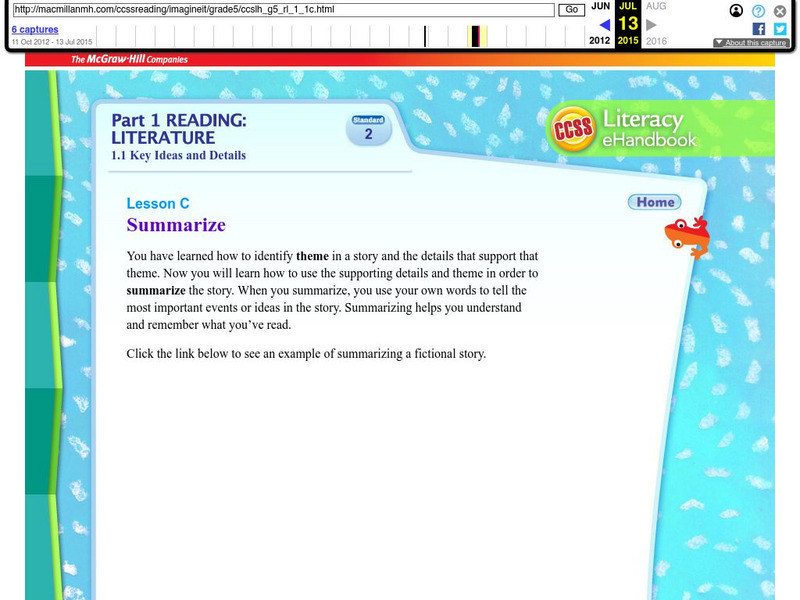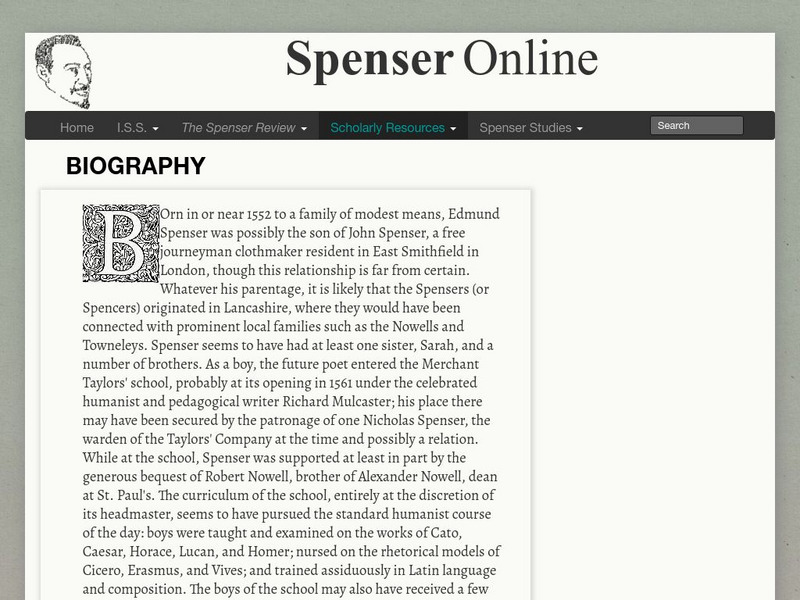Countries and Their Cultures
Countries and Their Cultures: Sotho
Provides an overview of the traditional culture and lifestyle of the Sotho of Lesotho and South Africa. Gives basic facts about location, language, folklore, foods, social customs, family life, education, religion, pastimes, societal...
Countries and Their Cultures
Countries and Their Cultures: Mozambicans
Provides an overview of the traditional culture and lifestyle of Mozambicans. Gives basic facts about location, language, folklore, foods, social customs, family life, education, religion, pastimes, societal challenges, etc. (Note:...
Countries and Their Cultures
Countries and Their Cultures: Galicians
Provides an overview of the traditional culture and lifestyle of the Galicians in northern Spain. Gives basic facts about location, language, folklore, foods, social customs, family life, education, religion, pastimes, societal...
Countries and Their Cultures
Countries and Their Cultures: Chagga
Provides an overview of the traditional culture and lifestyle of the Chagga of Tanzania. Gives basic facts about location, language, folklore, foods, social customs, family life, education, religion, pastimes, societal challenges, etc....
Countries and Their Cultures
Countries and Their Cultures: Bemba
Provides an overview of the traditional culture and lifestyle of the Bemba people of Zambia. Gives basic facts about location, language, folklore, foods, social customs, family life, education, religion, pastimes, societal challenges,...
Sophia Learning
Sophia: Referencing the Author's Purpose
This lesson explains how to reference an author's purpose when answering a reading comprehension question. This tutorial shares an audio version of the lesson's content. [3:14] RI.11-12.6 Eval Purpose, Rhetoric, Style
Other
Society of Professional Journalists: Freedom of Info.
This resource is a great tool for journalists and non-journalists to obtain information from federal and local government sources. Access to this information can make or break a news story.
Other
New York State Library: Student Activity: Primary Versus Secondary Sources
Read about the Railroad Strike of 1877 using three excerpts from textbooks and three original newspaper articles. Compare and contrast the information in the primary and secondary sources.
Education Development Center
Education Development Center: Tv411: Reading Structure of a News Story
Interactive instructional activity explains the content and organization of newspaper articles. Includes self-scoring exercises for practicing identifying the five W's (who, what, when, where, and why) in a series of brief news articles...
Education Development Center
Education Development Center: Tv411: Parts of a Newspaper
Learners click through a instructional activity about the parts of a newspaper and answer questions about the types of articles found in each section, headlines, and captions that would go with photographs. Links to related videos are...
Better Lesson
Better Lesson: Unit: The Author's Point Is
Middle schoolers will focus on Main Idea, Author's Purpose, Identifying supporting details and Organizing details. Students will read a variety of Informational Text (non-fiction) to understand how stated and implied main idea effect the...
Tom Richey
Slide Share: Author's Purpose and Point of View
This downloadable slideshow focuses on how an author's purpose and point of view work together in fiction and nonfiction, and how to identify the point of view.
Polk Brothers Foundation Center for Urban Education at DePaul University
De Paul University: Center for Urban Education: Inaugural Address by John F. Kennedy [Pdf]
This is a one-page nonfiction excerpt from JFK's Inaugural Address on January 20, 1961. It is followed by an open-ended question which requires students to provide evidence from the story; it includes underlining the most important...
Curated OER
Mc Graw Hill: Part 1 Reading: Literature: Summarize
Summarizing is a key skill needed in reading comprehension. This page describes how to summarize main ideas in a text. Click on Model button for a model with explanation and then click on Practice (Bottom Right)
Other
Fair: Retractions of Reporting Are Quite Selective
Interesting essay on the use of unnamed or anonymous sources, accuracy of reports, and retractions of innaccurate reports by major news outlets. Eye opener.
Other
Ire: Investigative Reporters and Editors
This non-profit group was created in 1975 as a networking tool for the exchange of ideas and attitudes concerning the quality of investigative reporting for the media. Site is newsletter-style with up-to-date information.
University of Cambridge
University of Cambridge: Spenser Online: Edmund Spenser: Biography
Biographical text on Edmund Spenser provides details of Spencers life and accomplishments as a poet and scholar.
Other
Pricewaterhouse Coopers: Financial Literacy Curriculum
A supplemental curriculum composed of easy to follow lesson plans, accompanied by interactive handouts and dynamic multimedia components. The goal is to provide students and educators access to financial literacy education.
Other
Sputnik Observatory for the Study of Contemporary Culture
A program designed to encourage thinking and ongoing learning in people who have the energy to develop ideas and work them through because the possibilities are endless.
CommonLit
Common Lit: "The Scottsboro Boys" by Jessica Mc Birney
A learning module that begins with the "The Scottsboro Boys" by Jessica McBirney, accompanied by guided reading questions, assessment questions, and discussion questions. The text can be printed as a PDF or assigned online through free...
CommonLit
Common Lit: "The Nature vs. Nurture Debate" by Common Lit Staff
A learning module that begins with "The Nature vs. Nurture Debate," accompanied by guided reading questions, assessment questions, and discussion questions. The text can be printed as a PDF or assigned online through free teacher and...
CommonLit
Common Lit: "Herd Behavior" by Common Lit Staff
A learning module that begins with "Herd Behavior," accompanied by guided reading questions, assessment questions, and discussion questions. The text can be printed as a PDF or assigned online through free teacher and student accounts....
CommonLit
Common Lit: Why Does No One Ever Thank Me for the Magna Carta?
CommonLit.org is a wonderful resource to use in a Language Arts classroom. Each story or article is accompanied by guided reading questions, assessment questions, and discussion questions. In addition, students can click on words to see...
CommonLit
Common Lit: Why Afghanistan's "Underground Girls" Skirt Tradition Live as Boys
CommonLit.org is a wonderful resource to use in a Language Arts classroom. Each story or article is accompanied by guided reading questions, assessment questions, and discussion questions. In addition, students can click on words to see...














